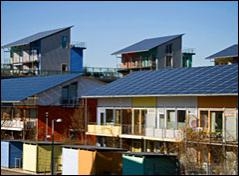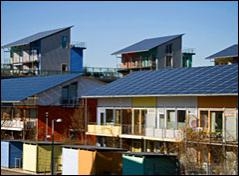The Property Assessed Clean Energy (PACE) finance tool helped thousands of homeowners pay for green improvements to their homes until Fannie Mae and Freddie Mac came out against it. Here’s the latest in the fight to save it:
 PACE programs may soon run up against the same barrier that’s blocked so much progress of late: a Senate that can’t manage to get much done.
PACE programs may soon run up against the same barrier that’s blocked so much progress of late: a Senate that can’t manage to get much done.
Senate Majority Leader Harry Reid (D-Nev.) said he is willing to add PACE-restoring legislation to a scaled-back energy bill, but only if a Republican cosponsor signs on to the plan, according to Brad Penney of the Alliance to Save Energy.
That may be the best hope of restoring the popular finance tool, which helped thousands of homeowners pay for home-energy retrofits and rooftop solar arrays until Fannie Mae and Freddie Mac told mortgage lenders to avoid it, throwing PACE programs across the nation into uncertainty.
Sen. Barbara Boxer (D-Calif.) introduced a bill last week that would require Fannie and Freddie to adopt standards that allow for PACE, which lets homeowners pay for improvements through a surcharge on their property tax bills. Boxer has three Democratic cosponsors but no Republican supporters. Reid, already short on time to pass an energy bill this year, may not be willing to add any provisions that could gum up the process.
Penney said his group had spoken to Republican Sens. Susan Collins (Maine), Olympia Snowe (Maine), Richard Lugar (Ind.), George LeMieux (Fla.), and George Voinovich (Ohio) about cosponsoring a PACE-fixing plan. So far, none has been willing.
“The time is too short to do this without Republican cosponsors,” said Cisco DeVries, who developed PACE three years ago as chief of staff to the mayor of Berkeley and now runs a company that sets up PACE programs. “We know there are Republicans who support this. We need them to sponsor and cosponsor bills.”
The PACE model should have bipartisan appeal. By reducing the upfront costs of improvements like insulation, sealing, and high-efficiency furnaces, it lets homeowners cut energy use and emissions, save on monthly utility bills, and give work to local contractors.
It should also appeal to opponents of big government. The programs are funded by local governments selling bonds on secondary markets, so the model essentially uses private capital to finance the improvements. Local governments have used similar tax assessments to fund local improvements, such as schools and sewers, for more than 100 years without federal interference.
“This is such an overreach of federal authority into a local government arena,” said Martin Chávez, former mayor of Albuquerque and director of ICLEI – Local Governments for Sustainability. “I would think conservative Republicans would be offended, no matter what they think of PACE.”
Fannie and Freddie worry about PACE users who default on their homes, leaving unpaid liens that must be paid off before mortgages — but research and past experience suggest that owners of energy-efficient homes are less likely to default
If that doesn’t work …
Another failure in the Senate would leave two options for saving PACE, neither of them appealing to supporters.
The first is litigation. California Attorney General (and Democratic candidate for governor) Jerry Brown has sued Fannie and Freddie over the issue, and Sonoma County, Calif., added its own suit this week. But resolution from the courts could take years.
The other option is a 30-month, 300,000-property pilot program floated last week by Long Island Rep. Steve Israel (D), who’s been active in defending Long Island PACE programs. The Federal Housing Finance Agency, Fannie and Freddie’s regulator, told Israel it would consider the idea.
But PACE advocates such as Penney and Chávez said they oppose a demonstration project, which they say would limit PACE’s growth and discourage Congress from addressing the problem.
“It’s a sucker program,” Chávez said. “We don’t need a pilot. We’ve had pilots and they’re working great. It’s time to move.”
[Clarification: Penney emailed to say he doesn’t oppose a demo project and considers it the “most feasible near-term option” unless legislation appears likely to pass.]
Their opposition to a pilot reveals just how big advocates think PACE could become. A pilot of 300,000 would dwarf existing programs — Sonoma County’s, the nation’s largest, has approved 1,292 applications in its first year and a half. But 22 states have passed bills allowing and encouraging municipalities to set up programs. If cities, towns, and counties take up the option, the tool could grow well beyond 300,000 users.
“I served five years in the [New Mexico] state senate, and any time we wanted to avoid an issue we formed a task force and we did a pilot program,” said Chávez. “It’s a way to get things off your desk. They ought to be able to step up and make a decision.”



